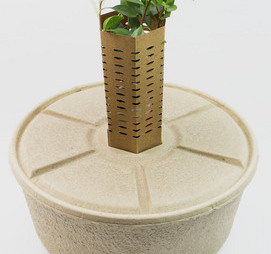
After winning the 2015 Green Challenge, Life Line Company wins the 2018 Greentec Award for Sustainable Development for there method to regreen degenerated forests.
The purpose of the COCOON is to support a seedling in its first year, when mortality rates for trees in nature are the highest. Its value lies in providing water and shelter and supporting soil life, together stimulating the seedling to produce healthy, proliferate and deep roots. Competing technologies often use irrigation and fertilizers, which results in a superficial root system, that depends on an ongoing dependency on external supply of water and nutrients.
The COCOON builds on natural principles and well-proven technologies, of which some are hundreds of years old. The COCOON has been demonstrated in numerous countries all over the world.It consists of a water reservoir, mycorrhizal fungi, a tree shelter and an evaporation sheet.
The components:
The water reservoir
The water reservoir is made of paper pulp, crop residuals or grasses and other FDA improved organic compounds to ensure water tightness during the first year. It is only filled once during planting. Water is sparsely transported to the tree using wicks. As the reservoir degrades and empties over time, the remaining shallow pits will serve as a micro-catchment to collect surface runoff during rain events. Additionally, the degraded reservoir becomes organic substrate ameliorating the soil.
Mycorrhizal fungi
Mycorrhizal fungi are added to the soil surrounding the roots of the plant. They increase the surface absorbing area of roots 100 to a 1,000 times. This improves access to soil moisture as well to the soil’s nutrients. Mycorrhizal fungi also release enzymes into the soil that dissolve hard-to-capture nutrients, such as organic nitrogen, phosphorus and, iron commonly fixed on to the soil complex. These fungi are present in 90% of natural forests and woodlands and form a critical, symbiotic relationship with the roots.
Tree shelter
A cylindrical shelter is placed around the tree to protect the plant against the sun, desiccating winds and smaller animals feeding on the young plant.
Evaporation sheet
A biodegradable evaporation sheet is placed above the reservoir, just below the topsoil. It practically eliminates evaporation of water in the soil and it prevents the growth of weeds near the seedling, which would otherwise compete for water, nutrients and light. Hence all available resources are directed towards tree establishment.
Together, these COCOON components create resilient trees with deep, proliferate root systems, well adapted to face the harsh conditions typifying drier regions. Bridging the drier top soil within the first year, trees subsequently tap into moister subsurface layers. As a result ‘COCOONed’ trees are better equipped to continue growing during the next dry seasons, resulting in higher survival rates and better performance.

Comments by our Users
Be the first to write a comment for this item.